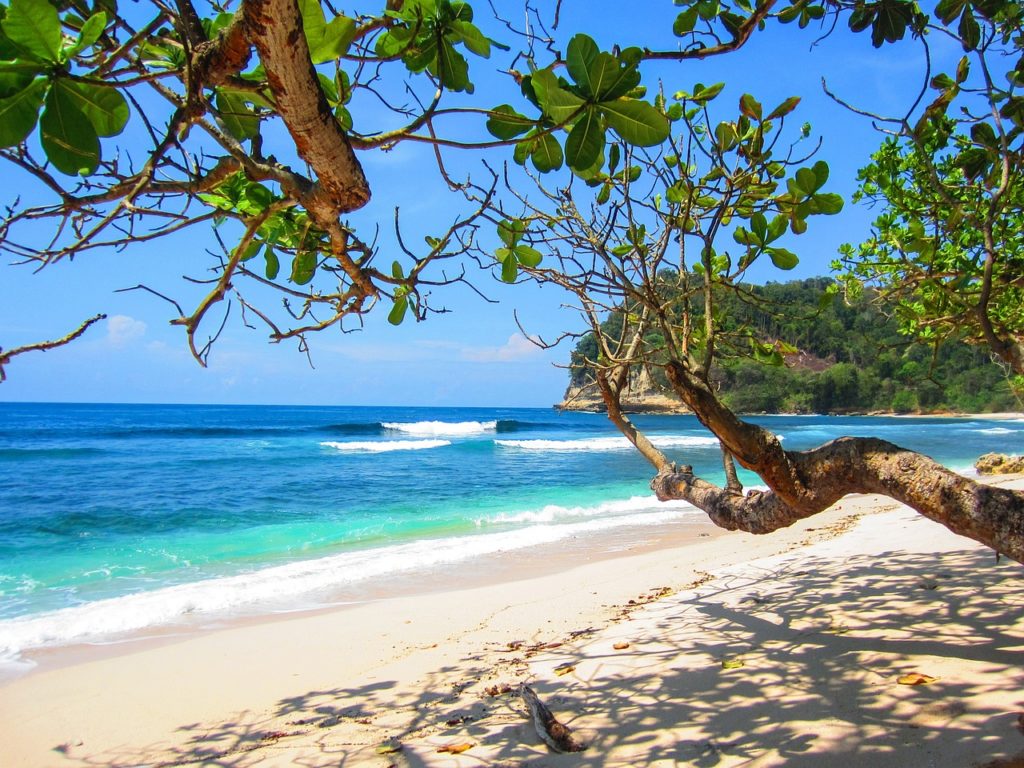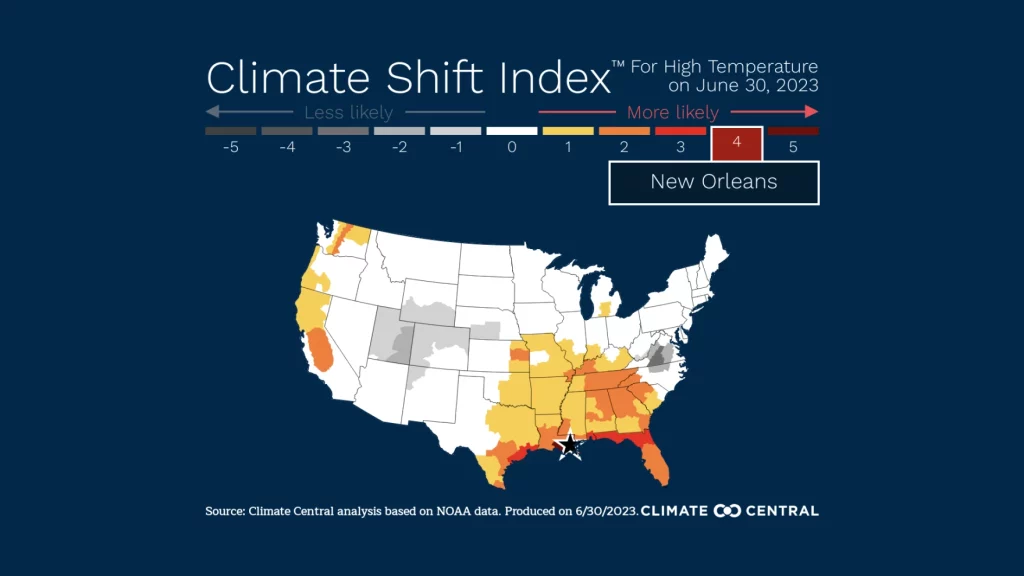
This is where I could be on these hot summer days. But I am here suffering like all of us.
Less than two weeks into the official start of summer, record-breaking heat has already swamped Louisiana and much of the South. And forecasters say the dangerous heat will likely continue. The Climate Prediction Center forecasts above-normal temperatures for at least the next three to four weeks. Even through September, the average temperature is expected to be higher than normal in much of Louisiana. “It does not mean that every single day will be above normal, but it means on average over the course of the next few months above normal seems like the more likely forecast on any given day,” said Ben Schott, a meteorologist with the National Weather Service’s Slidell Office. Above-normal temperatures don’t necessarily translate to long stints of extreme heat, but a persistent dome of heat sitting over the South has already triggered the highest number of excessive heat warnings in any given year. As of Friday, New Orleans had already experienced 8 days of hazardous heat after a lengthy stretch with heat indices above 110 degrees and nightly temperatures steadily sitting above 80 degrees. In 2022, the Slidell office issued five of such warnings.
wwno.org
Why the heat?
Heat is an invisible force created by a mix of ingredients in the earth’s atmosphere. Currently, the region has a massive high pressure bubble hovering in the area, which drives temperatures up. “When you have high pressure over the top of you, the air sinks, and when that happens, it compresses the atmosphere,” Schott said. “The physical effect of that is actually warming the air.” As the atmosphere is squashed down, the high pressure traps the heat. Unable to escape, the heat can get stuck recirculating in the area as the sun continues to beat down. This effect is compounded by the lack of rain. Schott said dry earth heats up even faster and radiates it outward. Though Louisiana hasn’t experienced the intense drought of the Midwest, the state is abnormally dry this summer, according to the U.S. Drought Monitor. Combine these factors with a steady stream of humid air from the Gulf of Mexico, and you have the potentially fatal weather that Louisianans are facing today, said Schott. The National Weather Service issues excessive heat warnings when the heat index – what the air feels like due to actual temperature and dew point – will exceed 113 degrees during the day. Schott said the agency will also issue warnings if the heat index is high and temperatures don’t drop below 80 degrees at night.

A graphic illustrating how high-pressure circulation in the atmosphere acts like a dome or cap, trapping heat at the surface and favoring the formation of a heat wave.
The danger we face.
Under the conditions of high temps during the day and the lack of cooling down at night, it’s difficult for your body to get any relief from the heat, posing a health threat as the body can start to break down after long-term heat exposure. “The cumulative effect on the body is very detrimental,” he said. Across the state, 2,700 people go to the emergency room for heat-related illnesses each year, according to a new report from the Louisiana Department of Health. Living or working outside in the heat can compromise your body’s ability to regulate its own temperature. When that happens, it can result in heat exhaustion, heat stroke and even death. Researchers have also found links to high temperatures and an increase in mental health issues. While heat can affect everyone, children and elderly people are especially vulnerable.
“They’re not able to control their body as well” as a healthy, young adult, Schott said. He added that income disparities can also leave people more exposed to heat if they have limited access to air conditioning, especially as nights grow hotter along with days. Climate Central, a nonpartisan science nonprofit, recently found that nighttime temperatures are warming nearly twice as fast as summer daytime highs. As human-fueled climate change continues and global temperatures rise, Louisiana can expect amplified extreme weather, from heatwaves to drought to hurricanes. According to Climate Central’s Climate Shift Index, climate change has made the recent weather in south Louisiana five times more likely to occur. The model looks at daily weather across the country and analyzes how much more common a weather pattern, like precipitation or temperature, is in an altered climate compared to a world without global warming. New Orleans as a city also experiences one of the most extreme urban heat island effects in the country as the asphalt and lack of trees makes it even hotter.

Stay cool.
One of the best ways to protect yourself from heat is to limit your time outdoors and stay in air- conditioned rooms with the windows closed. On the community-scale, the Centers for Disease Control and Prevention has also advised cities to use early heat wave warnings — like those issued by the National Weather Service — as a trigger for preventative actions like opening “cooling centers,” or publicly-accessible air-conditioned spaces. “Air-conditioning is the number-one protective factor against extreme heat, which is an essential health resource for vulnerable populations,” according to the CDC. Access to drinking fountains or swimming pools can also help people stay cool. In New Orleans, the city has opened overnight shelters for unhoused people as well as cooling centers and public pools to help combat the heat.
What is being done locally?
Where can you go around southeast Louisiana to stay cool? Though many of the parishes in the area don’t list cooling center resources, weather service officials recommend that people go to public spaces, such as libraries and malls, to get out of the heat. Many parishes also have sign-up forms for text alerts to notify residents when an extreme heat warning has been issued. Visit your parish’s social media pages or official parish websites for more information. The following parishes have listed the below options as cooling centers for residents:
Orleans Parish: The City of New Orleans has compiled a Heat Relief Map of public water fountains and cooling stations for residents to use during this time of extreme heat. NOLAready said that if there are other times that the National Weather Service (NWS) has issued an Excessive Heat Warning, the office will activate emergency cooling and overnight heat relief centers as well as water bottle and sunscreen giveaways at fire stations.
The New Orleans Recreation Development Commission has pools open throughout the week:
- Sanchez Center Pool: 1616 Fats Domino Ave, Monday through Friday from 2 to 6 p.m.
- Stallings Gentilly Pool: 2700 Lapeyrouse St, Thursday and Friday from 8 a.m. to 6 p.m.; Saturday from 9 a.m. to 2 p.m.
- Treme Pool: 900 N. Villere St, Monday through Friday from 4 to 7 p.m.; Saturday from 9 a.m. to 2 p.m.
- Lyons Pool: 624 Louisiana Ave, Thursday and Friday from 8 a.m. to 6 p.m.; Saturday from 9 a.m. to 2 p.m.
- Federal City Pool on Naval Base: 2220 Constitution St, Monday through Friday from 2 to 6 p.m.; Saturday from 9 a.m. to 2 p.m.
- Rosenwald Pool: 1120 N. Broad St, Monday through Friday from 4 to 9 p.m.; Saturday from 10 a.m. to 2 p.m.
- Pradat Pool: 7200 Dreux Ave, Thursday and Friday from 2 to 6 p.m.; Saturday from 9 a.m. to 2 p.m.
- Joe Brown Pool: 5620 Read Blvd, Monday through Friday from 8 a.m. to 7 p.m.; Saturday from 9 a.m. to 2 p.m.
All New Orleans library locations are open Monday through Saturday. For specific locations and times, check out their website. NOLA Ready also has alerts set up for people in the community to receive via text. Residents can opt in by texting NOLAREADY to 77295 and learn more information here. The city is also asking residents to call their non-emergency number, 311, to report if someone is in need of shelter during the excessive heat.
East Baton Rouge Parish: Libraries in Baton Rouge will be open during the weekends and weekdays, with all open Monday through Thursday from 9 a.m. to 9 p.m., Friday through Saturday from 9 a.m. to 6 p.m., and Sunday from 2 to 9 p.m. Each library has free wifi, charging stations and water fountains. Residents who are unhoused can go to the following shelters to cool off: Bishop Ott Day Center and Night Shelter, the Salvation Army Bed and Bread Shelter and the Missionaries of Charity. “We have shelters for the homeless population where these agencies have increased their capacity to respond to the heat,” Baton Rouge Mayor-President Sharon Weston-Broome told NPR.
Jefferson Parish: Residents can visit any of the 15 libraries located in Jefferson Parish to get out of the heat. For library locations and hours, visit the parish library website here. Parish officials also recommend going to a mall to avoid the heat, including Oakwood Center and Lakeside Shopping Center, which are open daily. Hours for Oakwood Center can be found here, and Lakeside Shopping Center hours are here.
St. Charles Parish: The parish has the Edward A. Dufresne Community Center open for their normal business hours, Monday through Friday, 8:30a.m. to 4p.m. at 274 Judge Edward Dufresne Parkway in Luling. Officials also urge residents to use their local library to beat the heat. Hours and locations for the St. Charles Parish Library system can be found here.
Terrebonne Parish: Libraries are open Monday through Thursday from 8:30 a.m. to 9 p.m., Friday and Saturday from 8:30 a.m. to 5 p.m., and the Main Library is open Sunday from 2 p.m. to 6 p.m.
A lot of options here.
